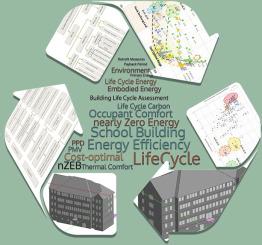Energy and Buildings ( IF 6.7 ) Pub Date : 2021-09-21 , DOI: 10.1016/j.enbuild.2021.111487 Nazanin Moazzen 1, 2 , Mustafa Erkan Karagüler 3 , Touraj Ashrafian 4

|
There has been an increasing interest in studying energy efficiency in buildings in the recent years, as they account for a significant portion of energy consumption and greenhouse gas emissions worldwide. While most of the studies focus on the buildings' operational phase, a substantial part of buildings' energy consumption is disguised as embodied energy. It is impossible to have a zero energy building, as it is necessary to use materials to build the building, and those materials need to produce and transport energy. Life cycle analysis is the utmost efficient method to assess how a building affects the environment. Notably, the impact of buildings on the environment across their lifespans are determined by some factors, which comprise materials, design, construction, use and demolition.
The study aims to present the implementation of a life cycle approach and occupant thermal comfort during the school building's energy efficiency design. The study's principal objective focuses on the energy use and environmental impact linked to various alternatives of building envelopes in different climates. Within this context, a reference building located in three different climatic regions of Turkey is investigated. Two ranges of efficiency comprise the focal points of the study. Cost-optimal and nearly zero energy levels are defined for each city. In the hot climate, the cost-optimal scenario cannot improve the comfort conditions, whereas the nZEB scenario improves slightly in such a context. In temperate and cold climates, both strategies can improve comfort conditions. The share of embodied energy and carbon in the nZEB level can reach higher than 80 percent, whereas it is lower than 15 percent in the cost-optimal level.
中文翻译:

考虑学校建筑生命周期能量和热舒适性的近零能耗和成本最优水平定义综合参数
近年来,研究建筑能效的兴趣越来越大,因为它们占全球能源消耗和温室气体排放的很大一部分。虽然大多数研究都集中在建筑物的运行阶段,但建筑物能源消耗的很大一部分被伪装成隐含能源。零能耗建筑是不可能的,因为建筑必须使用材料,而这些材料需要生产和运输能源。生命周期分析是评估建筑物如何影响环境的最有效方法。值得注意的是,建筑物在其整个生命周期中对环境的影响取决于一些因素,包括材料、设计、建造、使用和拆除。
该研究旨在介绍在学校建筑的能源效率设计期间实施生命周期方法和居住者热舒适度。该研究的主要目标侧重于与不同气候下建筑围护结构的各种替代方案相关的能源使用和环境影响。在此背景下,对位于土耳其三个不同气候区的参考建筑进行了调查。研究的重点包括两个效率范围。每个城市都定义了成本最优且几乎为零的能源水平。在炎热气候下,成本最优方案无法改善舒适条件,而 nZEB 方案在这种情况下略有改善。在温带和寒冷气候下,这两种策略都可以提高舒适度。


























 京公网安备 11010802027423号
京公网安备 11010802027423号